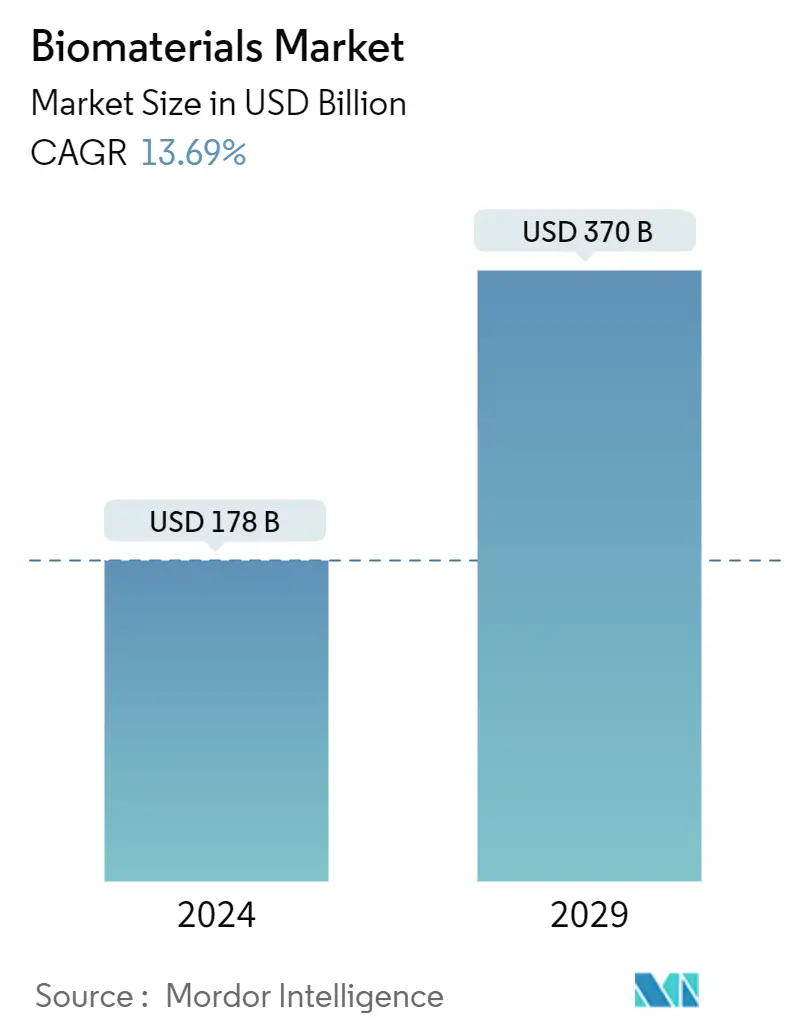Market Size of Biomaterials Industry

| Study Period | 2019 - 2029 |
| Market Size (2024) | USD 178 Billion |
| Market Size (2029) | USD 370 Billion |
| CAGR (2024 - 2029) | 13.69 % |
| Fastest Growing Market | Asia-Pacific |
| Largest Market | North America |
Major Players
*Disclaimer: Major Players sorted in no particular order |
Need a report that reflects how COVID-19 has impacted this market and its growth?
Biomaterials Market Analysis
The Biomaterials Market size is estimated at USD 178 billion in 2024, and is expected to reach USD 370 billion by 2029, growing at a CAGR of 13.69% during the forecast period (2024-2029).
The biomaterials market is poised to register a CAGR of 13.69% over the forecast period.
The COVID-19 pandemic had a significant impact on the market. The decline in non-emergency surgical procedures declined the demand for biomaterials during the pandemic. For instance, in April 2022, Nova Scotia's QEII Health Sciences Centre decided to postpone most non-urgent and elective surgeries due to the increasing number of patients with COVID-19 in the hospital.
As a result, the demand for biomaterials declined during the pandemic. However, the development of various biomaterials and biomedical devices is in demand for detecting and treating coronaviruses and is expected to rise over the forecast period.
In wound care, biomaterials are used to develop advanced dressings, scaffolds, and skin substitutes that enhance wound healing and minimize the risk of infections. They provide a conducive environment for tissue regeneration and promote faster healing. According to an article published by the Taylor & Francis Journal1 in June 2022, various biomaterials, including hydrogels, nanofibrous, composite, foam, spongy, bilayered, and trilayered scaffolds are being developed and fabricated to speed up the healing of chronic wounds. Therefore, the surging adoption of biomaterials for developing various wound healing products will burgeon market growth during the forecast period.
In addition, the rising number of wound injuries coupled with the high prevalence of diabetes is projected to drive market growth during the upcoming period. For instance, as per the data released by the International Diabetes Federation (IDF) in November 2022, approximately 537 million adults worldwide were living with diabetes in 2021. The number is projected to increase to 643 million by 2030 and 783 million by 2045. Therefore, the surging number of diabetic people is leading to growth in the number of wound injuries, thereby augmenting the growth of the biomaterials market.
Furthermore, the increasing number of multiple fractures and several injuries will likely drive market growth during the upcoming period. For instance, as per the data published by the CDC in May 2023, around 300,000 older people are hospitalized annually for hip fractures in the United States. According to the same source, approximately 3 million elderly people are treated in emergency departments for fall injuries every year. Therefore, the rising number of injuries is projected to drive the demand for biomaterials to develop medical implants.
The rising number of car accidents is also associated with traumatic fractures. For instance, according to the data published by Destatis in January 2023, it is estimated that over 29,000 people were injured in traffic accidents in Germany in November 2022. It has also been reported that this number increased by just under 2,400, or 9%, compared with the same month a year earlier, November 2021.
Thus, the factors above are expected to boost market growth over the forecast period. However, compatibility issues and stringent guidelines restrain the market's growth.
